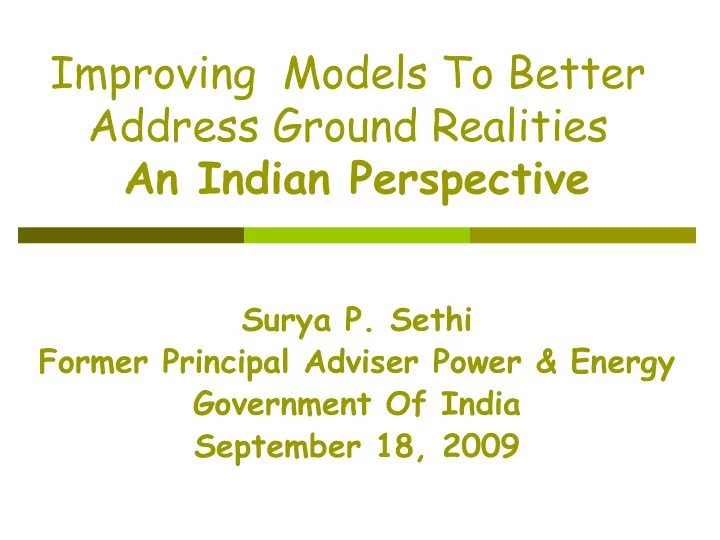

Improving Models To Better Address Ground Realities An Indian Perspective Surya P. Sethi Former Principal Adviser Power & Energy Government Of India September 18, 2009
India’s Energy Imperatives To Support 8% + Growth India’s primary energy supply to grow by 4.3-5.1% from the 2005-06 level of about 510 MTOE to reach 1536 to 1887 MTOE by 2031-32 for GDP growth of 8%+. India’s share of world fossil fuel supply in 2005 was 3.7%. This could become 7.6 to 10.9% by 2031-32. India’s incremental requirement could account for 13-21% of the world’s incremental supply by 2031-32. India would need to tap all available energy supplies and pursue all available and emerging energy technologies. Above all India must lower energy demand through 2 energy conservation and higher energy efficiency
India’s Energy Intensity Falling Energy intensity of GDP (kgoe/$ 2000 PPP) based on IEA data TPES (kgoe)/GDP ($2000 0.35 0.3 PPP) 0.25 0.2 0.15 1971 2001 1980 1990 1999 2003 2005 3
India Is NOT Following The Fuelish Path of Industrialized Countries 4
World Bank Assessment Of India’s Relative Emission’s Performance India is a relatively low carbon economy India has been offsetting its CO 2 emissions growth resulting from growth in population and high GDP growth by lowering energy intensity and improving the carbon intensity of its fuel mix India has achieved these offsets despite a low initial emission level and against a backdrop of increasing CO 2 intensity world wide between 1999-2004 Most independent projections indicate that India’s CO 2 intensity is likely to continue to decline through 2030- 2050 5
India’s Energy Consumption & Energy Intensity In The Global Context Country TPES Per Capita TPES /GDP (Kgoe)-2005 (Kgoe/$-2000 PPP)-2005 Russia 4520 0.47 China 0.22 1320 US 7890 0.21 Germany 4180 0.16 Japan 4150 0.15 Brazil 0.15 1120 India 468 0.15 UK 3880 0.14 Denmark 0.12 3620 World 1780 0.21 INDIA 2031-32 1065-1279 At Par With Best 6 Source : IEA, World Bank, 2031-32 estimate from Integrated Energy Policy
The 2 o C Poverty Trap (Annex I -40% by 2020 and -90% by 2050; Global Emissions -80% By 2050 From1990 Levels. Probability of exceeding 2 o C 14%-32%) 7 Source: Heinrich Boll Foundation, EcoEquity & Stockholm Env. Institute
CO 2 Emissions - 2005 2005 2005 2005 CO 2 emission population CO 2 emission/ (million tons) (million) Capita (tons) I. OECD 13548 1166 11.62 11515 2064 5.58 II. Countries with emission > 3 tons/ capita/annum in 2005 Sub-total (I+II) 25063 3230 7.76 III. Low emitters 3130 3215 0.97 Total 28193 6445 4.37 Assuming zero emissions from low emitters, 57.2 % reduction would be required within the borders of I & II to deliver 50 % of 1990 CO2 emission and 83% to deliver emissions at 20% of 1990 level. 8 Source: EIA, UN data base.
Per Capita Convergence In 2050 With Total CO 2 Emissions At 50 % of 1990 level 2050 Reduction over 2050 2005 CO 2 CO 2 emission population emission (%) (million tons) (million) 1539 88.64 1327 I. OECD 2721 76.37 2346 II. Countries with emission > 3 tons/ capita/annum in 2005 4260 83.00 3673 Sub-total (I+II) III. Low emitters 6462 -106.49 5571 10722 61.97 9244 Total Category III unlikely to trade their limited head room which will also vanish at 20% of 1990 level. Reductions must take place within the borders of I & II 9 Source: EIA, UN data base.
Different CGE Models Run For Same Scenarios Give Widely Varying Results For Indian Share Of Global Emissions Different CGE Models Different CGE Models Reference Scenario 550 ppmv Scenario 20 25 18 16 20 14 12 15 % % 10 8 10 6 4 5 2 0 0 2000 2050 2100 2000 2050 2100 GTEM MARIA GTEM MARIA merge-hc merge-hc EPPA EPPA merge-lc merge-lc AIM AIM DNE21 MiniCam DNE21 MiniCam IMAGE2.2 SGM IMAGE2.2 SGM Source: Weyant & Parikh, 2004 10
Qualitative Results: Carbon Intensity Of India’s GDP Will Keep Falling Source: Weyant & Parikh, 2004 11
Be The Change You Want To See In Be The Change You Want To See In The World The World 12
Recommend
More recommend